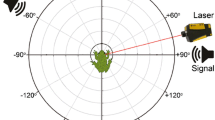Summary
-
1.
The magnitude and phase of sound transmitted through the avian interaural pathways were measured acoustically and with cochlear microphonic recordings.
-
2.
The acoustic measures indicated that a sound stimulus on one side of the head could be conducted through the tympanic membrane and across the interaural pathway to the opposite middle ear with an attenuation of about 25–35 dB.
-
3.
The acoustic loss was primarily due to sound transmission across the tympanic membrane, with no further attenuation attributed to sound conduction through the interaural pathways.
-
4.
A comparison of cochlear microphonic recordings during ipsilateral or contralateral stimulation indicated a loss of 15–20 dB due to sound conduction across the contralateral tympanic membrane and interaural pathways.
-
5.
Sound conducted through the interaural pathway exhibited a frequency dependent phase delay.
-
6.
The consequences of binaural stimulation on the cochlear microphonic response could be predicted by a vector addition of the response to monaural ipsilateral or contralateral stimulation.
-
7.
The maintenance of a constant SPL at the contralateral ear varied the cochlear response to ipsilateral stimuli, in a frequency dependent manner, by as much as ±2 dB.
-
8.
It is hypothesized that the chick interaural pathways act like the air filled trachae of insects, which connect the bilateral ears and are thought to be important in auditory localization.
Similar content being viewed by others
Abbreviations
- CM :
-
cochlear microphonics
- SPL :
-
sound pressure level
- TM :
-
tympanic membrane
References
Chung, S.H., Pettigrew, A., Anson, M.: Dynamics of the amphibian middle ear. Nature272, 142–147 (1978)
Feng, A.S., Capranica, R.R.: Sound localization in anurans. I. Evidence of binaural interactions in dorsal medullary nucleus in bullfrogs (Rana catesbeiana). J. Neurophysiol.39, 871–881 (1975)
Henson, O.W.: Comparative anatomy of the middle ear. In: Handbook of sensory physiology, Vol. V/1. Keidel, W.D., Neff, W.F. (eds.), pp. 39–110. Berlin, Heidelberg, New York: Springer 1974
Hill, K.G., Boyan, G.S.: Directional hearing in crickets. Nature262, 390–391 (1976)
Lewis, D.B.: The physiology of the tettigonid ear. IV. A new hypothesis for acoustic orientation behavior. J. Exp. Biol.60, 861–869 (1974)
Michelsen, A.: The physiology of the locust ear. III. Acoustical properties of the intact ear. Z. Vergl. Physiol.71, 102–128 (1971)
Michelsen, A., Larsen, O.N.: Biophysics of the Ensiferan ear. I. Tympanal vibrations in bushcrickets (Tettigoniidae) studied with laser vibrometry. J. Comp. Physiol.123, 193–203 (1978)
Michelsen, A., Nocke, H.: Biophysical aspects of sound communication in insects. Adv. Insect Physiol.10, 247–296 (1974)
Miller, L.A.: Directional hearing in the locust,Schistocerca gregaria Forskål (Acrididae, Orthoptera). J. Comp. Physiol.119, 85–98 (1977)
Mills, A.W.: Auditory localization. In: Foundations of modern auditory theory, Vol. 2. Tobias, J.V. (ed.), pp. 301–348. New York: Academic Press 1972
Nocke, H.: Physical and physiological properties of the tettigonid (“grasshopper”) ear. J. Comp. Physiol.100, 25–57 (1975)
Payne, R.S.: Acoustic localization of prey by barn owls (Tyto alba). J. Exp. Biol.54, 535–573 (1971)
Saunders, J.C., Coles, R.B., Gates, G.R.: The development of auditory evoked responses in the cochlea and cochlear nuclei of the chick Brain Res.63, 59–74 (1973)
Saunders, J.C., Hirsch, K.A.: Changes in cochlear microphonic sensitivity after priming C57BE/6J mice at various ages for audiogenic seizures. J. Comp. Physiol. Psychol.90, 212–220 (1976)
Schwartzkopff, J.: Untersuchungen über die Arbeitsweise des Mittelohres und das Richtungshören der Singvögel unter Verwendung von Cochlea-Potentialen. Z. Vergl. Physiol.34, 46–68 (1952)
Schwartzkopff, J., Bremond, J.C.: Méthode de dérivation des potentiels cochléaires chez l'Oiseau. J. Physiol. (Paris)55, 495–518 (1963)
Stellbogen, E.: Über das äußere und mittlere Ohr des Waldkauzes (Syrnium aluca). Z. Morphol. Ökol. Tiere19, 686–731 (1930)
Stewart, G.W.: The acoustic shadow of a rigid sphere, with certain applications in architectural acoustics and audition. Phys. Rev.33, 467–479 (1911)
Strother, W.F.: The electrical responses of the auditory mechanisms in the bullfrog (Rana catesbeiana). J. Comp. Physiol. Psychol.52, 157–162 (1959)
Tonndorf, J.: Bone conduction. In: Foundations of modern auditory theory, Vol. 2. Tobias, J.V. (ed.), pp. 195–237. New York: Academic Press 1972
Wada, Y.: Beiträge zur vergleichenden Physiologie der Gehörorgane. Pflügers Arch.202, 46–69 (1923)
Wever, E.G., Vernon, J.A.: Auditory responses in the spectacled caiman. J. Cell. Comp. Physiol.50, 333–339 (1957)
Author information
Authors and Affiliations
Additional information
We would like to thank Drs. G.R. Bock, C.W. Brown, J. Rheinländer and E. Relkin for their willingness to discuss the research presented in this paper and for their experimental insights which proved most helpful. We would also like to thank M.B. Schiavo, V.M. Mayer and R. Pallone for their help in the preparation of this manuscript. This work was supported in part by NSF award BNS77-26868, and was performed in the Auditory Research Laboratory of the Philadelphia Veteran's Hospital
Dr. Rosowski is presently a fellow of the Research Laboratory of Electronics, Massachusetts Institute of Technology and of the Eaton Peabody Laboratory of Auditory Research, Massachusetts Eye and Ear Infirmary, Boston, Massachusetts
Rights and permissions
About this article
Cite this article
Rosowski, J.J., Saunders, J.C. Sound transmission through the avian interaural pathways. J. Comp. Physiol. 136, 183–190 (1980). https://doi.org/10.1007/BF00657532
Accepted:
Issue Date:
DOI: https://doi.org/10.1007/BF00657532




